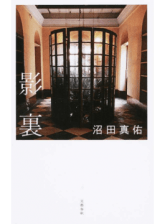Numata Shinsuke 沼田真佑. Eiri 影裏. Bungei Shunjū, 2017.
This won the 157th A-Prize, for early 2017.
Yamashita (b. 1978) is a true newcomer. This is his first published work of fiction. His selection seems to have gotten some notoriety because of that. The story is also a 3/11 story, and I’m a little shocked to realize it’s the first Prize-winner to directly (or even, I’d argue, indirectly) deal with the disaster. Not that literature in Japan as a whole has shied away from it. I don’t know if the Prize as an institution decided to wait a few years so as not to appear to be capitalizing on it, or if it’s just coincidence; anyway, there’s enough distance that the Prize committee wouldn’t appear to be rewarding the choice of theme per se.
The story is told by an unnamed narrator (“watashi”) who works for a company in Morioka. When he transferred there a number of years ago he befriended another guy in the company, Hiasa. They went fishing together a lot in the back-country streams and rivers. Then Hiasa quits and goes to work as a salesman, and then the narrator loses touch with him, and then the earthquake happens, and months later he realizes nobody’s heard from Hiasa. He tries to track him down and learns that Hiasa disappeared in the tsunami. The narrator goes to meet Hiasa’s father to urge him to report his son’s disappearance, but the father had disowned his son in anger before his death when it turned out that he had forged his college credentials – so what had he been doing in Tokyo those four years with all the college money his father had been sending him?
The story ends, then, with irresolution and mystery. Who was Hiasa really? Did his father ever really know him? Did the narrator? And, of course: Is he dead? Will anyone ever know for sure?
And: If he’s dead, what was he thinking in the moments before he died? We’re told that Hiasa had a childlike enthusiasm for watching things be destroyed, or seeing things that had been destroyed. There’s a scene where he exults over a fallen tree out in the woods that sets us up for, at the end of the story, the narrator’s suspicion that as Hiasa watched the tsunami approach he was transfixed, fascinated.
And: What are the narrator’s feelings toward Hiasa? Their relationship is only described in terms of male bonding over fishing, but late in the story we learn in the vaguest of ways that the narrator had a male lover in college; now the lover has had sex reassignment surgery (the term used in the story) and is female. They almost get together when the former lover comes up to Sendai on a business trip, but don’t. The distant nature of their current relationship, combined with their former, barely mentioned, relationship, suggests that the narrator is gay and might have been attracted to Hiasa in ways that were not reciprocated. Irresolution and mystery.
The title comes from a zen motto seen on the wall in Hiasa’s father’s house; it means something like “behind the light” but the full motto is “lightning flashes, cutting the spring wind.” It comes from an old story where a zen priest, threatened with death at swordpoint, says these words, meaning (basically) lightning might slice through wind but the wind isn’t damaged. So: Hiasa could be alive? Or, rather, the afterimage he’s left on the people around him does not fade?
I’ll confess I found the story a frustrating read, although now that I write it out like this it seems pretty attractive. The narrative is more fragmented even than is usual for literary narrative in Japan (which already prizes fragmented narratives), and I found it hard to follow the chronology, and not in a pleasant way; I also wanted to know more about the narrator, his background, and his feelings, and was frustrated there. I didn’t find the prose to be striking at all (except for a preponderance of fish names), although members of the committee single out this aspect of the work for praise. But upon reflection I do appreciate the sense of loss created by these irresolvable questions.
No bonus story in this volume; at the time of publication in book form it was the author’s only completed fiction.
